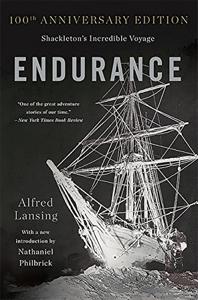
Want to learn the ideas in Endurance better than ever? Read the world’s #1 book summary of Endurance by Alfred Lansing here.
Read a brief 1-Page Summary or watch video summaries curated by our expert team. Note: this book guide is not affiliated with or endorsed by the publisher or author, and we always encourage you to purchase and read the full book.
Video Summaries of Endurance
We’ve scoured the Internet for the very best videos on Endurance, from high-quality videos summaries to interviews or commentary by Alfred Lansing.
1-Page Summary of Endurance
Overall Summary
In 1914, Ernest Shackleton sets out to explore Antarctica. He purchased a sturdy wooden boat designed for hunting polar bears and changed the name of it to ‘Endurance’. However, despite warnings from experienced whalers that he should not attempt to cross the Weddell Sea (due to its unreliability), he proceeds with his plan. His ship is battered by enormous ice floes on a consistent basis and ultimately sinks in November 1915. After abandoning the Endurance, Shackleton establishes camps on various ice floes, moving tents, sledge dogs and food stores accordingly.
The men tried to travel by dog sled on the ice pack, but it was too slow and difficult. They had to chop through pressure ridges with axes in order to move forward. Eventually they decided that travelling by sea floe would be easier, but wind and weather conditions were unpredictable. However, the crew remained optimistic throughout their ordeal; they ate penguins and seals for food and killed some of their dogs for food as well.
The warming sea temperatures cause the pack ice to break up. It also causes cracking and deterioration of the floes, which are large pieces of floating ice that form in Arctic waters. As a result, Shackleton’s men have to evacuate on emergency basis several times because deep crevices form in the floe they’re camping on. In spring 1918, Shackleton directs his crew into three small open wooden boats after a perilous series of misadventures with the floe. After reuniting at Elephant Island, they establish a camp there but realize it is too small for them all so some move elsewhere while others stay behind. To get help from South Georgia Island (the nearest inhabited island), Shackleton selects five crew members to accompany him in crossing the Drake
Finally, the men reach an outpost where they are celebrated by veteran whaling captains. They were aware of what the men had accomplished and Shackleton rescues his remaining crew members from South Georgia Island. He attempts to rescue those left behind on Elephant Island but is unable to do so because pack ice surrounds it. Finally, he saves all of them by delivering them back to England without any fatalities along the way.
Part I, Chapter 1
The Endurance is trapped in the Antarctic ice. The ship’s condition worsens by the minute. Engineers are desperately trying to keep up with the rising water levels and failing pumps, but they know that it won’t be long before there’s no hope left for them or their comrades on board.
The men were calm as they prepared to leave the ship. They attached a canvas chute to the rail and slid each dog down it onto the ice below. The sky was clear, but there was movement in the ice that worked like a jigsaw puzzle to cut up and separate the ship into two pieces. The men noticed how much like an animal dying in agony their ship behaved at this time.
Shackleton realizes that his crew is stranded and will not be rescued. They are 346 miles away from the nearest land, which is uninhabited. A Swedish crew had left supplies on Paulet Island when their ship was crushed by ice.
Part I, Chapter 2
The goal of the expedition was to cross Antarctica from west to east. The difficulty is illustrated by the fact that it took until 1958 for someone to accomplish this feat, and then with heated vehicles, planes, and powerful radios. Shackleton had braved the region twice before. In 1901 he accompanied Robert F Scott on an expedition into Antarctica; in 1907 he led his own expedition within 97 miles of the pole but was thwarted by lack of food. Upon returning home he was knighted and awarded heroic status for his efforts





